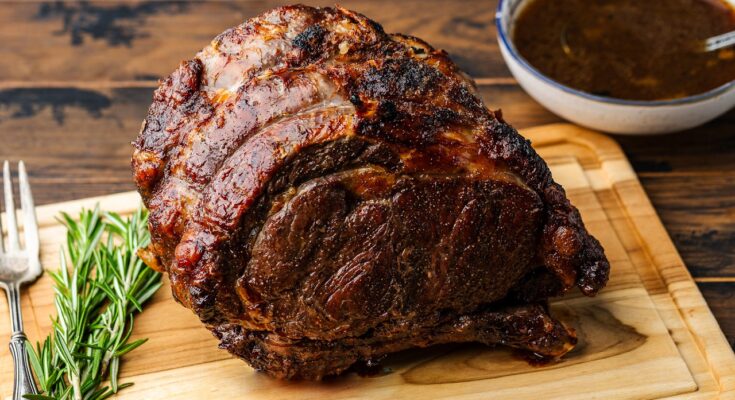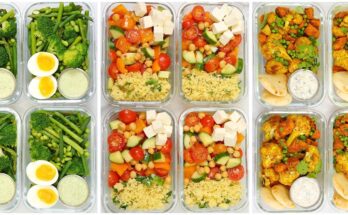Beef Rib Recipe: When it comes to hearty, flavor-packed meals, beef ribs steal the show. Whether you’re firing up the grill or slow-cooking them until they fall off the bone, beef ribs offer a deeply satisfying bite that’s rich, tender, and mouthwateringly savory. This guide isn’t just another recipe—it’s a full-proof method to achieve restaurant-quality ribs from the comfort of your kitchen. Perfect for weekend barbecues, cozy dinners, or anytime you’re craving something indulgent.
So, why are beef ribs so popular? It’s simple: the marbled fat content and bone-in cooking make them naturally juicy and flavorful. They’re like the steak version of comfort food—bold and unforgettable. This recipe walks you through every step, from selecting the best ribs to seasoning, cooking, and serving them like a pro.
Ingredients You’ll Need
Before diving in, let’s make sure you have everything you need. Here’s a comprehensive list to get you started:
Main Ingredients:
- 3–4 lbs of beef ribs (short ribs or back ribs)
- 2 tablespoons olive oil
- Salt and pepper to taste
Dry Rub Mix:
- 1 tablespoon smoked paprika
- 1 tablespoon garlic powder
- 1 tablespoon onion powder
- 1 teaspoon chili powder
- 1 teaspoon brown sugar
- ½ teaspoon cayenne pepper (optional for heat)
For the Marinade (optional alternative to dry rub):
- 1/4 cup soy sauce
- 2 tablespoons Worcestershire sauce
- 2 cloves garlic, minced
- 1 tablespoon honey or brown sugar
- 1 teaspoon black pepper
Optional Add-ons for Cooking:
- 1 cup beef broth or beer (for moisture)
- Sliced onions and carrots (if slow cooking)
- BBQ sauce for basting or dipping
Each of these ingredients plays a role in enhancing the flavor of your ribs. While the rub gives you a crusty, smoky surface, the marinade seeps deep into the meat, making it succulent and savory.
Choosing the Right Beef Ribs
Not all beef ribs are created equal, and your choice of cut can drastically affect the outcome.
Types of Beef Ribs:
- Back Ribs: These come from the upper part of the cow and are known for their curved bone and leaner meat. Great for grilling and baking.
- Short Ribs: Cut from the lower portion (chuck or plate), these are meatier and more marbled. Ideal for slow-cooking or braising.
Tips for Selecting Quality Ribs:
- Look for Marbling: The more fat streaks, the juicier and more flavorful the meat.
- Avoid Dry Edges: This might indicate older meat that’s been sitting for a while.
- Uniform Size: Choose ribs with even thickness so they cook uniformly.
Always ask your butcher for their freshest cuts. Don’t hesitate to request a little trimming if you want to avoid excessive fat or connective tissue.
Preparing the Ribs
Preparation is where the magic begins. Start by rinsing the ribs under cold water and patting them dry with paper towels. Then, inspect the bone side—if there’s a silvery membrane (also called silver skin), gently peel it off. This membrane doesn’t break down during cooking and can make your ribs chewy.
Steps to Prep the Ribs:
- Trim excess fat, leaving just enough for flavor.
- Remove the membrane by sliding a knife under the edge and pulling it off using a paper towel for grip.
- Marinate or rub depending on your flavor profile. If you’re short on time, go with a rub. If you’ve got several hours or overnight, a marinade will infuse deeper flavor.
Marinating should last at least 2 hours but preferably overnight. For dry rubs, you can season them right before cooking or let them sit in the fridge for up to 12 hours for more robust flavor.
Dry Rub vs. Marinade
Let’s settle the debate: dry rub or marinade? Both bring something different to the table.
Dry Rub Advantages:
- Creates a flavorful crust.
- Better for grilling and oven-roasting.
- Doesn’t require long marination time.
Marinade Perks:
- Infuses meat deeply with flavor.
- Tenderizes tougher cuts.
- Perfect for slow cooking.
Simple Rub Recipe:
Combine smoked paprika, garlic powder, onion powder, chili powder, brown sugar, and cayenne pepper. Rub evenly all over the ribs.
Easy Marinade Recipe:
Mix soy sauce, Worcestershire, honey, minced garlic, and black pepper. Place ribs in a large bag or bowl, pour marinade over them, and refrigerate.
Choose based on your method and timeline. Want crusty grilled ribs? Go with a rub. Planning to slow cook all day? Marinade it is.
Cooking Methods
When it comes to cooking beef ribs, your method determines everything—texture, flavor, and how juicy your final product turns out. Here are three of the best ways to make them shine:
1. Oven-Baked
Oven-baking offers control and consistency. You can slowly cook the ribs at a low temperature, letting the fat render and the meat become melt-in-your-mouth tender. This method is great for home cooks without access to a grill or smoker.
2. Grilling
Grilling gives your ribs that iconic charred flavor. It’s perfect for back ribs which are leaner and cook quicker. Grilling does require more attention—monitoring the heat and flipping at the right times—but it rewards you with smokiness and a delicious crust.
3. Slow-Cooking
Slow-cookers or Crockpots are your best friends for effortless, fall-apart ribs. Just set it and forget it. Add some broth, onions, and your marinated ribs—six to eight hours later, you’ll have incredibly tender meat.
Each method has its charm, so it really depends on your tools and what kind of finish you’re aiming for.
Step-by-Step: Oven-Baked Beef Ribs
Step 1: Preheat and Prepare
Set your oven to 300°F (150°C). Line a baking sheet with foil for easy cleanup and place a wire rack on top if you want extra airflow.
Step 2: Season the Ribs
Pat your ribs dry and apply your dry rub or remove them from the marinade. Make sure the seasoning covers every nook and cranny.
Step 3: Wrap and Bake
Place the ribs bone side down on the rack. Cover tightly with foil to create a steaming environment that breaks down connective tissues. Bake for 2.5 to 3 hours.
Step 4: Uncover and Glaze
Remove the foil. If you like saucy ribs, brush on BBQ sauce and return to the oven at 425°F (220°C) for 10-15 minutes. This caramelizes the sauce for a sticky, sweet finish.
Pro Tips:
- Don’t rush. Low and slow is the secret to tender beef ribs.
- Let them rest for 10 minutes before cutting to retain juices.
Step-by-Step: Grilled Beef Ribs
Step 1: Preheat the Grill
Set your grill to medium-low heat, aiming for around 275°F (135°C). If using charcoal, place coals on one side for indirect cooking.
Step 2: Prep and Season
Apply your rub and let the ribs sit at room temperature for about 30 minutes. This helps with even cooking.
Step 3: Indirect Grilling
Place the ribs on the cooler side of the grill, bone side down. Close the lid and cook for 2.5 to 3 hours, turning every 30-40 minutes.
Step 4: Finish with Direct Heat
Move the ribs over direct heat for the last 5-10 minutes to char the exterior. Brush with BBQ sauce during the last few minutes if you like a sticky finish.
Grill Master Tips:
- Use a meat thermometer. Aim for an internal temp of 190°F (88°C) for maximum tenderness.
- Use soaked wood chips for an added smoky layer.
Step-by-Step: Slow Cooker Beef Ribs
Step 1: Sear the Ribs (Optional but Recommended)
In a hot skillet, sear the ribs for 2-3 minutes per side. This adds a layer of flavor you just can’t get from slow cooking alone.
Step 2: Load the Slow Cooker
Place sliced onions and carrots at the bottom of your Crockpot. Add ribs on top and pour in 1 cup of beef broth or beer. Add a splash of Worcestershire sauce for depth.
Step 3: Cook Low and Slow
Cover and cook on low for 8 hours or high for 4-5 hours. You’ll know they’re done when they’re fork-tender and almost falling apart.
Step 4: Sauce and Broil (Optional)
Remove ribs, coat with BBQ sauce, and broil in the oven for 5 minutes to caramelize the glaze.
Slow Cook Tips:
- Don’t overcrowd the pot. Layering works fine, but make sure they’re not packed too tightly.
- Reserve the juices. Strain and reduce them on the stove for a killer gravy or sauce.
Sauces and Glazes
The right sauce can elevate beef ribs from great to unforgettable. Whether you’re team BBQ or prefer a sweet and tangy glaze, your options are endless. Here’s how to make your ribs shine with flavor:
Classic BBQ Sauce Options
BBQ sauce comes in all varieties—smoky, spicy, sweet, or tangy. You can go with store-bought options, but making your own ensures depth and freshness. Here’s a simple homemade version:
Basic BBQ Sauce Recipe:
- 1 cup ketchup
- 1/4 cup apple cider vinegar
- 1/4 cup brown sugar
- 2 tablespoons Worcestershire sauce
- 1 tablespoon smoked paprika
- 1 teaspoon garlic powder
- 1/2 teaspoon black pepper
- Optional: 1 teaspoon hot sauce for heat
Simmer everything together for about 15 minutes. You’ll get a rich, bold flavor perfect for brushing onto ribs during the last stage of cooking or serving on the side.
Sweet and Sticky Glaze Recipe
For a glossy finish with an Asian twist, try this:
- 1/3 cup honey
- 2 tablespoons soy sauce
- 1 tablespoon hoisin sauce
- 1 teaspoon grated ginger
- 1 teaspoon sesame oil
Heat and stir until slightly thickened. Brush onto your ribs and broil for a sweet-savory crust that’s simply irresistible.
Tips for Using Sauces:
- Apply during the final 10-15 minutes of cooking to avoid burning the sugars.
- Save some for dipping; people love having extra on the side.
Side Dishes to Serve with Beef Ribs
Beef ribs are the star, but the supporting cast makes the meal memorable. Here are some side dish ideas that complement the richness of the ribs:
Classic Pairings:
- Coleslaw: Crunchy, tangy, and refreshing, it balances the fatty ribs.
- Cornbread: Slightly sweet and crumbly—perfect for soaking up sauce.
- Mashed Potatoes: Creamy and smooth, it contrasts beautifully with meaty ribs.
Creative Twists:
- Grilled Veggie Skewers: Peppers, mushrooms, and zucchini charred to perfection.
- Mexican Street Corn (Elote): Slathered with mayo, lime, and chili powder.
- Garlic Butter Green Beans: Adds a pop of freshness and color to your plate.
A good side dish brings balance. Think light, crunchy, or acidic to cut through the richness of the meat.
Presentation Tips
They say you eat with your eyes first, and when it comes to ribs, presentation can make all the difference—especially if you’re serving guests.
Tips for Plating Beef Ribs:
- Slice Between the Bones: Clean cuts make it easier to serve and eat.
- Use a Large Platter: Pile them high or arrange in a fan pattern.
- Garnish with Style: Sprinkle chopped parsley, fresh herbs, or even a light dusting of smoked paprika for color.
Serving Sauces and Sides:
- Use ramekins or small bowls for sauces.
- Place sides in contrasting dishes—something rustic like wood bowls or cast iron makes for a charming presentation.
Don’t forget napkins. Beef ribs are hands-on, so keep the table guest-friendly with wet wipes or lemon-scented towels.
Common Mistakes to Avoid
Even seasoned cooks can mess up ribs if they’re not careful. Here are the top blunders to steer clear of:
1. Skipping the Membrane Removal
Leaving the silverskin on makes ribs chewy and rubbery. Always check the back of the ribs before cooking.
2. Cooking Too Fast
Beef ribs need time. Rushing the process will leave you with tough, dry meat. Low and slow is the golden rule.
3. Not Seasoning Enough
Under-seasoning is a crime. Be generous with your rub or marinade—these thick cuts need it to penetrate the meat.
4. Saucing Too Early
If you apply sauce too soon, especially with high sugar content, it’ll burn. Wait until the end to brush on your glaze.
5. Overcrowding the Pan or Grill
This restricts airflow and leads to uneven cooking. Give each rib space to breathe and crisp up properly.
Awareness of these pitfalls will keep your ribs tender, juicy, and loaded with flavor every single time.
Storing and Reheating Leftovers
Got leftovers? Great! Beef ribs store surprisingly well and can be just as delicious the next day—if you handle them right.
Storage Tips:
- Refrigerator: Store in an airtight container for up to 4 days.
- Freezer: Wrap ribs in foil and place in a zip-lock bag. They’ll last up to 3 months.
Reheating Methods:
1. Oven (Best Method):
- Preheat oven to 275°F (135°C).
- Place ribs on a baking tray with a splash of beef broth.
- Cover with foil and heat for 20-25 minutes.
2. Microwave (Quick Fix):
- Use medium power and cover with a damp paper towel.
- Heat in 30-second intervals.
3. Air Fryer (For a Crisp Finish):
- Heat at 350°F (175°C) for about 6-8 minutes.
- Great for getting back that BBQ-like crisp.
Avoid overcooking during reheating, or you’ll dry them out. A little added moisture like broth or sauce works wonders to revive the tenderness.
FAQs about Beef Rib Recipe
1. What is the best cut of beef for ribs?
The most popular cuts for beef ribs are back ribs and short ribs. Back ribs come from the upper part of the cow and are meatier, while short ribs are thicker and richer with more fat—perfect for slow cooking.
2. How long should I cook beef ribs?
Beef ribs need low and slow heat. If you’re grilling or smoking, cook them for 3–4 hours at 225°F (107°C). In the oven, bake at 300°F (150°C) for 2.5–3 hours. They’re ready when the meat is tender and pulling away from the bone.
3. Should I boil beef ribs before grilling?
Boiling isn’t necessary and can reduce flavor. Instead, marinate or dry rub your ribs and slow cook them. The key is low heat over time, not boiling.
4. Can I make beef ribs in the oven?
Absolutely! Oven-baked beef ribs are a great option. Wrap them in foil, season well, and bake low and slow for fall-off-the-bone deliciousness.
5. What’s the best seasoning for beef ribs?
A simple dry rub of salt, black pepper, garlic powder, paprika, and a touch of brown sugar works wonders. Want more heat? Add cayenne. Prefer bold? Try a smoky BBQ blend.
6. How do I know when beef ribs are done?
You’ll know they’re done when the meat is tender, juicy, and pulls away from the bone with ease. An internal temp of 190–203°F (88–95°C) is ideal for that melt-in-your-mouth texture.
7. Can I freeze cooked beef ribs?
Yes, cooked beef ribs freeze well. Let them cool, wrap tightly in foil or a freezer bag, and store for up to 3 months. Reheat slowly for best results.
8. What sides go best with beef ribs?
You can’t go wrong with coleslaw, cornbread, mashed potatoes, grilled veggies, or baked beans. Balance the richness of the ribs with something crisp or tangy.
Conclusion
Beef ribs aren’t just food—they’re an experience. With their bold flavors, tender texture, and smoky aroma, they have the power to turn any dinner into a celebration. Whether you’re baking, grilling, or slow-cooking, following the steps in this guide will guarantee you end up with ribs that are juicy, flavorful, and downright irresistible.
Cooking the perfect beef rib takes patience, quality ingredients, and a bit of love. But the result? A dish that’s worth every second of effort.



